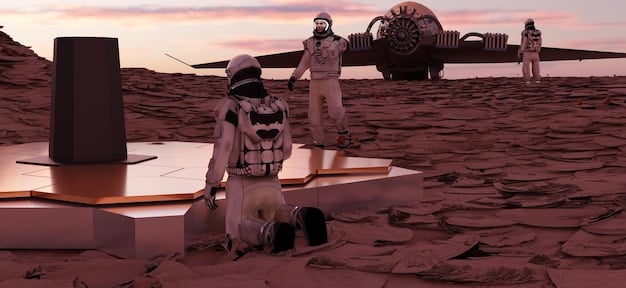NASA’s 2025 Deep Space Budget: Impact on Private Sector Contracts

The projected 15% increase in NASA’s 2025 deep space exploration budget is poised to significantly expand opportunities for private sector involvement, fostering innovation through new contracts and partnerships aimed at advancing lunar and Martian missions, while reinforcing commercial space capabilities and reducing direct governmental costs for deep space endeavors.
In a landscape increasingly defined by collaborative ventures, the projected 15% increase in NASA’s 2025 deep space exploration budget signals a monumental shift with far-reaching implications. This anticipated boost is not merely an allocation of more funds but an intentional strategic move designed to accelerate ambitious missions, particularly those targeting the Moon and Mars, while profoundly reshaping the relationship between public agencies and the private space industry. Understanding how this financial injection will ripple through the private sector, catalyzing new contracts and fostering innovation, is crucial for anyone keen on the future of space exploration.
Understanding the 15% Budget Increase for Deep Space
The proposed 15% increase in NASA’s 2025 deep space exploration budget is a robust affirmation of the agency’s commitment to pushing the boundaries of human knowledge and technological capability. This significant increment is not arbitrary; it responds to the escalating costs of complex, long-duration missions and the ambition to maintain leadership in the global space race. It will primarily underwrite critical phases of the Artemis program, which aims to return humans to the Moon and establish a sustainable lunar presence, a vital stepping stone for future Mars endeavors.
This budgetary expansion underscores a clear strategic imperative: to accelerate development work, mitigate schedule risks, and infuse new technologies into existing and planned missions. By bolstering funding, NASA intends to move beyond conceptual designs and into tangible hardware development and operational readiness. The increase also accounts for inflation and the burgeoning complexity of advanced space systems, ensuring that foundational research and development can keep pace with mission objectives.
Historically, significant budgetary increases have correlated directly with ambitious new programs. This 15% rise suggests a renewed vigor in NASA’s deep space agenda, aiming for a more frequent and sustained human presence beyond Earth orbit. It’s a testament to the belief that continued investment in space exploration yields invaluable scientific discovery, technological advancements, and economic benefits, extending far beyond the immediate scope of space missions.
Drivers Behind the Budgetary Expansion
Several factors converge to necessitate and justify this substantial budget increase. The inherent challenges of deep space missions—radiation exposure, extreme temperatures, and the vast distances involved—demand sophisticated and often custom-built technologies. Furthermore, the global competition in space, with nations like China and private entities intensifying their efforts, places pressure on NASA to maintain its pioneering role.
- Artemis Program Acceleration: The ambitious timeline for returning humans to the Moon and building foundational infrastructure requires consistent and substantial funding.
- Mars Mission Preparations: Developing the technologies and life support systems for eventual human missions to Mars is an incredibly resource-intensive undertaking.
- Technological Innovation: Investing in cutting-edge propulsion systems, advanced robotics, and in-situ resource utilization (ISRU) to reduce mission costs and increase capabilities.
- International Collaboration: Maintaining partnerships relies on NASA’s ability to commit substantial resources, providing a solid foundation for shared risks and rewards.
This financial commitment is a deliberate step towards transforming the theoretical possibilities of human deep space travel into concrete realities, setting the stage for a new era of exploration that will undoubtedly rely heavily on robust partnerships.
Direct Impacts on Private Sector Contracts and Opportunities
The projected 15% increase in NASA’s deep space exploration budget is not just a boon for the agency; it represents a seismic shift for the private space sector. This influx of capital is expected to translate into a significant proliferation of new contracts, expanding the scope and scale of private sector involvement in lunar and Martian endeavors. Companies, both established aerospace giants and agile startups, will find unprecedented opportunities to contribute across various mission phases.
Historically, NASA has increasingly relied on commercial partners for services such as cargo resupply to the International Space Station (ISS) and commercial crew transportation. The deep space budget increase extends this paradigm to more ambitious domains. We anticipate an surge in requests for proposals (RFPs) for critical mission components, ranging from lunar landers and habitats to advanced propulsion systems and long-duration life support technologies. This move is strategic; by leveraging private sector innovation and efficiency, NASA can accelerate progress while potentially reducing overall costs and managing risks more effectively.
Furthermore, the increased budget is likely to foster more public-private partnerships (PPPs) where the private sector takes on greater responsibility for design, development, and operations, often sharing both the financial burden and the potential rewards. This model stimulates private investment and commercialization, moving beyond traditional government contracting to a more symbiotic relationship where both parties are incentivized for success. It signifies a maturation of the commercial space industry, where companies are no longer mere suppliers but integral partners in deep space objectives.

Key Areas for Private Sector Engagement
The increased budget will unlock new avenues for collaboration across a spectrum of deep space activities. This expansion will require specialized expertise and innovative solutions from the commercial realm.
- Lunar Lander Development: Continued and expanded contracts for Human Landing Systems (HLS), supporting multiple providers to ensure redundancy and foster competition.
- Deep Space Habitats & Infrastructure: Opportunities for companies to develop and manufacture modules for lunar Gateway and future surface habitats, essential for sustained human presence.
- Advanced Propulsion Systems: Investment in chemical, electric, and nuclear propulsion technologies to enable faster and more efficient transit times to the Moon and Mars.
- Resource Utilization (ISRU): Contracts for developing technologies to extract and process resources like lunar ice, reducing reliance on Earth-launched supplies.
- Robotics and Automation: Increased demand for autonomous systems for reconnaissance, construction, and maintenance in extreme environments.
- Communications & Navigation: Development of robust deep space communication networks and precise navigation systems for distant missions.
These specialized areas offer fertile ground for both established aerospace firms and nimble startups to secure lucrative contracts, shaping the trajectory of deep space exploration for decades to come.
Challenges and Risks for Private Sector Collaboration
While the projected 15% increase in NASA’s deep space budget presents unparalleled opportunities for the private sector, it is crucial to acknowledge the inherent challenges and risks that accompany such ambitious endeavors. The deep space environment is unforgiving, demanding exceptionally high reliability and fault tolerance in all systems. This translates into stringent technical requirements and rigorous testing protocols, which can be costly and time-consuming for private companies, particularly smaller ones lacking extensive heritage in space-faring systems.
One significant challenge lies in the long development cycles and uncertain return on investment that characterize deep space projects. Unlike closer-to-Earth commercial ventures, deep space missions often lack immediate commercial revenue streams, making private financing difficult to secure without substantial government commitments. Companies must navigate complex intellectual property rights agreements and data sharing policies with NASA, ensuring that their innovations are protected while also serving the broader public interest of scientific discovery.
Furthermore, the political landscape and continuity of funding remain perennial risks. Multi-year budget allocations can be subject to changes in administration priorities or congressional appropriations, potentially disrupting project timelines and financial stability for contractors. The “new space” companies, while agile and innovative, may find the cultural and procedural differences between their often fast-paced, risk-tolerant approach and NASA’s more deliberate, safety-first methodology to be a significant hurdle. Bridging this gap requires effective communication, mutual understanding, and adaptable contractual frameworks.
Navigating Regulatory and Technical Hurdles
For private entities to succeed in this expanded role, they must meticulously address regulatory frameworks and overcome formidable technical barriers. Compliance with ITAR (International Traffic in Arms Regulations) and export control laws is paramount, given the sensitive nature of space technology, particularly when international partnerships are involved.
- Stringent Safety Standards: Adhering to NASA’s demanding safety and quality assurance standards for human-rated spacecraft and systems is non-negotiable and resource-intensive.
- Long Development Timelines: Deep space projects often span decades, requiring sustained investment and patient capital, which can be challenging for private investors seeking quicker returns.
- Technology Validation in Extreme Environments: Proving that components and systems can withstand the harsh conditions of deep space (radiation, vacuum, extreme temperatures) requires extensive and costly testing.
- Supply Chain Dependency: Reliance on a global supply chain for specialized components introduces vulnerabilities and regulatory complexities that must be managed.
- Data and IP Management: Establishing clear agreements on data ownership, intellectual property rights, and commercialization pathways post-mission.
Successfully navigating these intricate challenges will distinguish robust private sector partners capable of consistently delivering against NASA’s ambitious deep space objectives.
Strategic Implications for the Future of Space Exploration
The projected 15% budget increase for NASA’s deep space exploration in 2025 carries profound strategic implications that extend far beyond simply accelerating current missions. It signifies a deliberate pivot towards a more sustainable and economically viable model of space exploration, one heavily reliant on the ingenuity and efficiency of the private sector. This strategic shift aims to create a robust space economy where government agencies act as anchor customers and facilitators, while commercial entities drive innovation, reduce costs, and ultimately expand access to space for a wider array of activities.
By empowering private companies with significant contracts, NASA is effectively nurturing an ecosystem where capabilities developed for governmental missions can also find commercial applications. This dual-use potential is critical for long-term sustainability. For instance, technologies perfected for lunar habitats or Martian life support systems could eventually serve commercial space tourism, resource extraction, or even off-world manufacturing. This approach encourages private investment, as companies see a clearer path to profitability beyond initial government contracts, fostering a vibrant, self-sustaining space industry.
Moreover, the increased reliance on commercial partners inherently introduces an element of diversification and redundancy. Instead of a single, monolithic government-led effort, multiple companies may compete and collaborate, providing backup solutions and fostering a healthier innovation environment. This competition can drive down costs and speed up development, allowing NASA to achieve more with its enhanced budget. It positions the United States at the forefront of a global effort to extend humanity’s presence beyond Earth, not solely through public spending, but through a dynamic partnership with its private sector.
Fostering a Self-Sustaining Lunar Economy
A key strategic outcome of this budget increase is the accelerated development of a lunar economy. By funding private lunar landers, resource utilization technologies, and habitat structures, NASA is laying the groundwork for more than just scientific missions; it’s building essential infrastructure for commercial activity on the Moon.
- Commercial Lunar Payload Services (CLPS): Expanded contracts within CLPS facilitate regular deliveries to the lunar surface by private companies, establishing supply lines.
- Resource Extraction Technologies: Prioritizing funding for private development of ISRU technologies, such as regolith processing or water ice extraction, crucial for reducing mission costs.
- Private Habitat Development: Incentivizing commercial entities to build habitation modules that could one day support tourism, research, or even manufacturing.
- Lunar Communications and Navigation: Developing commercial services for lunar communications and positioning systems, vital for all future lunar operations.
This strategic investment is designed to transition lunar exploration from a purely government-funded endeavor into a commercially sustainable enterprise, with NASA acting as a catalyst for private involvement and investment.
Case Studies of Successful Public-Private Partnerships
Examining past successes provides valuable insights into how the projected 15% budget increase could further amplify the impact of public-private partnerships in deep space. The commercial resupply and crew programs for the International Space Station (ISS) serve as prime examples. Companies like SpaceX and Northrop Grumman, through their respective Dragon and Cygnus spacecraft, have demonstrated the efficiency and innovation possible when NASA acts as an anchor customer, providing clear requirements and initial funding while allowing private industry to develop and operate the transportation systems.
Another compelling case study involves the Commercial Lunar Payload Services (CLPS) initiative. Under CLPS, NASA contracts with private companies to deliver scientific instruments and technology demonstrations to the lunar surface. This program has diversified lunar access, allowing multiple companies to design and build their own landers, fostering competition and accelerating development cycles. Companies like Intuitive Machines and Astrobotic have secured CLPS contracts, proving that smaller, agile private entities can undertake complex lunar missions, significantly expanding NASA’s reach. These partnerships demonstrate that by outsourcing specific services, NASA can focus its resources on fundamental research, mission planning, and critical oversight, while the private sector handles the operational delivery.
These successes are not without their challenges, but they illustrate a fundamental shift in how NASA approaches mission execution. The agency is moving from direct development of almost every component to leveraging commercial capabilities wherever possible. This frees up agency resources for the truly unique and frontier-pushing aspects of deep space exploration that only a government agency can undertake, such as fundamental scientific discovery and planetary protection, while relying on the private sector for routine operations and infrastructure development. The 15% budget increase will enable NASA to scale up these successful models to the more demanding deep space domain.
Lessons Learned from Prior Collaborations
The journey of public-private partnerships is fraught with learning curves. Key lessons from previous collaborations will inform how the new deep space budget is allocated and managed to ensure maximal impact and efficiency.
- Clear Requirements and Communication: Ambiguity in requirements or communication gaps can lead to costly delays and rework. Detailed, clear statements of work are crucial.
- Risk Sharing Mechanisms: Successful partnerships often involve explicit frameworks for sharing both technical and financial risks, incentivizing performance rather than penalizing inevitable challenges.
- Flexibility in Contracting: Adapting contract types (e.g., fixed-price vs. cost-plus) based on the maturity of technology and mission complexity can optimize outcomes.
- Performance-Based Incentives: Tying payments to specific milestones and successful demonstrations motivates commercial partners to achieve objectives efficiently.
- Fostering Competition: Maintaining a competitive environment among multiple providers stimulates innovation and helps control costs.
These lessons are invaluable as NASA embarks on even more ambitious deep space ventures, with an enhanced budget setting the stage for deeper and more complex integrations with the private sector.
Regulatory Environment and Policy Considerations
The influx of a 15% budget increase for NASA’s deep space exploration necessitates a close examination of the existing regulatory environment and impending policy considerations. A robust and clear regulatory framework is essential to ensure safety, promote fair competition, and protect national interests as private entities take on increasingly complex roles beyond Earth orbit. Current regulations, largely tailored for traditional government-led space activities, may require significant adaptation to accommodate the burgeoning commercial deep space industry.
One critical policy area concerns the allocation of orbital and surface resources. As more private entities plan missions to the Moon and potentially Mars, questions of property rights, resource extraction, and orbital debris management become pressing. The Outer Space Treaty of 1967 provides a foundation but lacks specific provisions for commercial resource utilization. Therefore, congressional action and international agreements will be pivotal in establishing clear guidelines that encourage investment while preventing conflict and ensuring the long-term sustainability of space activities. The US Commercial Space Launch Competitiveness Act of 2015 offers some domestic framework for asteroid resource rights, but its applicability to lunar resources and international acceptance remains debated.
Furthermore, policies related to export control (e.g., ITAR), intellectual property rights, and liability for potential accidents or mission failures will need continuous refinement. As private companies develop proprietary technologies for deep space, safeguarding their investments while ensuring broad access to scientific data and advancements for public benefit presents a delicate balancing act. The increased budget offers an opportunity to proactively address these policy gaps, ensuring that the regulatory landscape is an enabler, not a hindrance, to America’s deep space ambitions and private sector participation.
Evolving Policy to Support Commercial Expansion
To fully capitalize on the enhanced budget and drive innovation, policymakers must consider several key areas where regulatory evolution is critical. This involves creating an environment that balances commercial freedom with responsible governance.
- International Collaboration and Treaties: Active participation in developing international norms and agreements for lunar and Martian activity, ensuring peaceful and sustainable exploration.
- Liability Frameworks: Updating and clarifying liability regimes for commercial deep space operations, considering the unique risks involved.
- Resource Governance: Developing clear, enforceable policies on property rights and resource extraction in non-terrestrial bodies to incentivize private investment.
- Licensing and Authorization: Streamlining licensing processes for novel deep space missions and technologies to avoid unnecessary delays for commercial ventures.
- Data Sharing and Open Science: Crafting policies that promote the sharing of scientific data from commercially-led missions while respecting proprietary interests.
Proactive policy development will be instrumental in translating the increased budget into tangible advancements and sustainable commercial opportunities in deep space.
Broader Economic and Societal Benefits
The projected 15% budget increase for NASA’s deep space exploration, and its cascading effect on private sector contracts, promises significant broader economic and societal benefits that extend far beyond the immediate objectives of space missions. Historically, investments in space have spurred a multitude of terrestrial innovations. This enhanced funding is expected to accelerate the development of cutting-edge technologies in areas such as advanced materials, artificial intelligence, robotics, and life support systems, which often find unexpected applications in fields like medicine, environmental science, and manufacturing, leading to new industries and job creation.
Economically, the boosted contracts for the private sector translate into high-skill job growth across various engineering, scientific, and manufacturing disciplines. This is not limited to traditional aerospace hubs but can stimulate regional economies where new space companies emerge or expand. The “trickle-down” effect of space spending can be substantial, as private companies hire more personnel, invest in new facilities, and procure goods and services from a wide array of suppliers, reinforcing the economic fabric of communities nationwide.
Societally, deep space exploration continues to inspire future generations in STEM (Science, Technology, Engineering, and Mathematics) fields. Ambitious missions to the Moon and Mars capture public imagination, motivating students to pursue careers that are critical for national competitiveness and innovation. Furthermore, the scientific discoveries brought back from extraterrestrial environments—whether new insights into planetary formation, the search for life, or understanding extreme environments—enrich human knowledge and our place in the universe. This profound impact on human curiosity, inspiration, and intellectual advancement is an invaluable societal return on investment, underpinning the enduring value of pushing boundaries beyond Earth.
Spin-off Technologies and STEM Inspiration
The relationship between deep space investment and terrestrial benefits is well-documented. This new budget infusion will undoubtedly lead to new innovations that improve life on Earth and inspire a new generation of scientists and engineers.
- Medical Advancements: Technologies for remote health monitoring, advanced diagnostics, and closed-loop life support initially developed for astronauts find applications in telemedicine and critical care on Earth.
- Material Science: Development of lightweight, high-strength materials for spacecraft leads to lighter vehicles, more efficient energy systems, and durable consumer products.
- Artificial Intelligence and Robotics: AI-driven systems and advanced robotics for autonomous space operations transfer to applications in manufacturing, logistics, and hazardous environment exploration on Earth.
- Environmental Technologies: Innovations in water purification, recycling, and closed-loop systems for space habitats can offer solutions to Earth’s resource challenges.
- STEM Workforce Development: The excitement and challenges of deep space exploration naturally attract and motivate students to pursue STEM careers, addressing critical workforce gaps.
These diverse benefits underscore that investments in deep space exploration are not merely expenditures but strategic investments in humanity’s collective future, yielding dividends across multiple sectors.
| Key Point | Brief Description |
|---|---|
| 🚀 Budget Boost Impact | 15% increase expands deep space missions, especially Artemis and Mars preparation, fostering innovation. |
| 🤝 Private Sector Contracts | Surge in RFPs for lunar landers, habitats, propulsion, and ISRU, inviting diverse private involvement. |
| 🚧 Challenges Ahead | Strict reliability, long development cycles, IP issues, and funding continuity pose risks for private partners. |
| 🌎 Wider Benefits | Spinoff technologies, high-skill job creation, and STEM inspiration enrich global economy and society. |
Frequently Asked Questions About NASA’s 2025 Deep Space Budget
▼
The 15% budget increase is primarily allocated to advancing the Artemis program, including lunar landers, habitats, and support systems for sustainable presence on the Moon. A significant portion also targets research and development for future human missions to Mars, focusing on advanced propulsion, life support, and in-situ resource utilization technologies to make deep space travel more efficient and feasible.
▼
The budget increase is expected to create new opportunities for small and medium-sized private companies through specialized subcontracts and increased demand for niche technologies. NASA’s Commercial Lunar Payload Services (CLPS) model, for example, allows smaller entities to compete for lunar delivery missions, fostering innovation and diversification in the private space sector. It levels the playing field beyond just large aerospace prime contractors.
▼
New contract types are likely to emerge focused on sustained lunar infrastructure (e.g., power grids, communication networks), in-space manufacturing, and advanced deep space habitats. There will also be a growing need for commercial services like space situational awareness beyond Earth orbit and private ventures in resource prospecting and extraction, signaling a deeper integration of commercial capabilities into core mission operations.
▼
While the immediate focus of the budget increase is on lunar capabilities, the advancements made there are critical stepping stones for Mars. Investments in long-duration life support, radiation shielding, and efficient propulsion systems for lunar transit directly translate to Mars mission readiness. While an exact accelerated timeline isn’t guaranteed, the funding significantly de-risks and propels the technological development necessary for eventual human exploration of Mars.
▼
The long-term economic benefits include significant job creation in high-tech sectors, spin-off technologies applicable in various industries (e.g., medical, energy), and the establishment of a robust space economy. Investment fosters innovation, attracts global talent, and reinforces the U.S.’s competitive edge in the rapidly growing international space market, stimulating economic growth and national prestige for decades to come.
Conclusion
The projected 15% increase in NASA’s 2025 deep space exploration budget marks a pivotal moment, signaling a resolute commitment to expanding humanity’s reach beyond low Earth orbit. This substantial investment is poised to dramatically accelerate ambitious lunar and Martian endeavors, but its most transformative impact lies in its potential to revolutionize the relationship between NASA and the private sector. By fueling an unprecedented array of commercial contracts for everything from advanced propulsion to lunar infrastructure, this budget boost will catalyze innovation, foster competition, and drive down costs, ultimately creating a more dynamic and diversified space economy. While challenges remain in navigating complex technical and regulatory landscapes, the long-term benefits—from new technologies to inspiring future generations—underscore that this financial commitment is a strategic investment in both the future of space exploration and broader societal progress.





